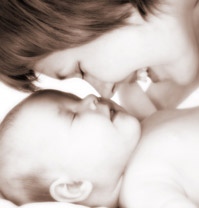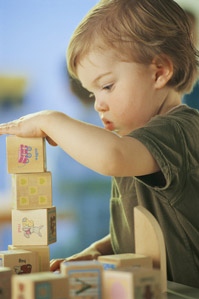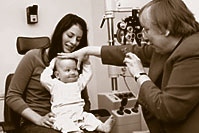Infant Vision: Birth to 24 Months of Age
- Steps in Infant Vision Development
- Signs of Eye and Vision Problems
- What Parents Can do to Help With Visual Development
- Baby's First Eye Exam
 From birth, babies begin exploring the wonders in the world with their eyes. Even before they learn to reach and grab with their hands or crawl and sit-up, their eyes are providing information and stimulation important for their development.
From birth, babies begin exploring the wonders in the world with their eyes. Even before they learn to reach and grab with their hands or crawl and sit-up, their eyes are providing information and stimulation important for their development.Healthy eyes and good vision play a critical role in how infants and children learn to see. Eye and vision problems in infants can cause developmental delays. It is important to detect any problems early to ensure babies have the opportunity to develop the visual abilities they need to grow and learn.
Parents play an important role in helping to assure their child's eyes and vision can develop properly. Steps that any parent should take include:
- Watching for signs of eye and vision problems.
- Seeking professional eye care starting with the first comprehensive vision assessment at about 6 months of age.
- Helping their child develop his or her vision by engaging in age-appropriate activities.
Steps in Infant Vision Development
At birth, babies can't see as well as older children or adults. Their eyes and visual system aren't fully developed. But significant improvement occurs during the first few months of life.The following are some milestones to watch for in vision and child development. It is important to remember that not every child is the same and some may reach certain milestones at different ages.
Birth to four months
 At birth, babies' vision is abuzz with all kinds of visual stimulation. While they may look intently at a highly contrasted target, babies have not yet developed the ability to easily tell the difference between two targets or move their eyes between the two images. Their primary focus is on objects 8 to 10 inches from their face or the distance to parent's face.
At birth, babies' vision is abuzz with all kinds of visual stimulation. While they may look intently at a highly contrasted target, babies have not yet developed the ability to easily tell the difference between two targets or move their eyes between the two images. Their primary focus is on objects 8 to 10 inches from their face or the distance to parent's face.- During the first months of life, the eyes start working together and vision rapidly improves. Eye-hand coordination begins to develop as the infant starts tracking moving objects with his or her eyes and reaching for them. By eight weeks, babies begin to more easily focus their eyes on the faces of a parent or other person near them.
- For the first two months of life, an infant's eyes are not well coordinated and may appear to wander or to be crossed. This is usually normal. However, if an eye appears to turn in or out constantly, an evaluation is warranted.
- Babies should begin to follow moving objects with their eyes and reach for things at around three months of age.
Five to eight months
- During these months, control of eye movements and eye-body coordination skills continue to improve.
- Depth perception, which is the ability to judge if objects are nearer or farther away than other objects, is not present at birth. It is not until around the fifth month that the eyes are capable of working together to form a three-dimensional view of the world and begin to see in depth.
- Although an infant's color vision is not as sensitive as an adult's, it is generally believed that babies have good color vision by five months of age.
- Most babies start crawling at about 8 months old, which helps further develop eye-hand-foot-body coordination. Early walkers who did minimal crawling may not learn to use their eyes together as well as babies who crawl a lot.
 At around 9 months of age, babies begin to pull themselves up to a standing position. By 10 months of age, a baby should be able to grasp objects with thumb and forefinger.
At around 9 months of age, babies begin to pull themselves up to a standing position. By 10 months of age, a baby should be able to grasp objects with thumb and forefinger.- By twelve months of age, most babies will be crawling and trying to walk. Parents should encourage crawling rather than early walking to help the child develop better eye-hand coordination.
- Babies can now judge distances fairly well and throw things with precision.
- By two years of age, a child's eye-hand coordination and depth perception should be well developed.
- Children this age are highly interested in exploring their environment and in looking and listening. They recognize familiar objects and pictures in books and can scribble with crayon or pencil.
Signs of Eye and Vision Problems
The presence of eye and vision problems in infants is rare. Most babies begin life with healthy eyes and start to develop the visual abilities they will need throughout life without difficulty. But occasionally, eye health and vision problems can develop. Parents need to look for the following signs that may be indications of eye and vision problems:- Excessive tearing - this may indicate blocked tear ducts
- Red or encrusted eye lids - this could be a sign of an eye infection
- Constant eye turning - this may signal a problem with eye muscle control
- Extreme sensitivity to light - this may indicate an elevated pressure in the eye
- Appearance of a white pupil - this may indicate the presence of an eye cancer
[back to top]
What Parents Can do to Help With Visual Development
There are many things parents can do to help their baby's vision develop properly. The following are some examples of age-appropriate activities that can assist an infant's visual development.Birth to four months
- Use a nightlight or other dim lamp in your baby's room.
- Change the crib's position frequently and change your child's position in it.
- Keep reach-and-touch toys within your baby's focus, about eight to twelve inches.
- Talk to your baby as you walk around the room.
- Alternate right and left sides with each feeding.

- Hang a mobile, crib gym or various objects across the crib for the baby to grab, pull and kick.
- Give the baby plenty of time to play and explore on the floor.
- Provide plastic or wooden blocks that can be held in the hands.
- Play patty cake and other games, moving the baby's hands through the motions while saying the words aloud.
- Play hide and seek games with toys or your face to help the baby develop visual memory.
- Name objects when talking to encourage the baby's word association and vocabulary development skills.
- Encourage crawling and creeping.
- Roll a ball back and forth to help the child track objects with the eyes visually.
- Give the child building blocks and balls of all shapes and sizes to play with to boost fine motor skills and small muscle development.
- Read or tell stories to stimulate the child's ability to visualize and pave the way for learning and reading skills.
Baby's First Eye Exam
Even if no eye or vision problems are apparent, at about age 6 months, you should take your baby to your doctor of optometry for his or her first thorough eye examination.
Things that the optometrist will test for include:
- excessive or unequal amounts of nearsightedness, farsightedness, or astigmatism
- eye movement ability
- eye health problems.
 InfantSEE® is the American Optometric Association's public health program designed to ensure that eye and vision care becomes an integral part of infant wellness care to improve a child's quality of life. Under this program, participating optometrists provide a comprehensive infant eye assessment between 6 and 12 months of age as a no-cost public service. Click here to learn more and locate a doctor in your area who can provide the free infant assessment.
InfantSEE® is the American Optometric Association's public health program designed to ensure that eye and vision care becomes an integral part of infant wellness care to improve a child's quality of life. Under this program, participating optometrists provide a comprehensive infant eye assessment between 6 and 12 months of age as a no-cost public service. Click here to learn more and locate a doctor in your area who can provide the free infant assessment.[back to top]
